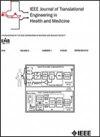对步长变异性敏感的按需提示:了解其对帕金森病患者步态的影响
IF 4.4
3区 医学
Q2 ENGINEERING, BIOMEDICAL
IEEE Journal of Translational Engineering in Health and Medicine-Jtehm
Pub Date : 2025-04-24
DOI:10.1109/JTEHM.2025.3563381
引用次数: 0
摘要
帕金森病(PD)的特点是步态障碍,步态冻结(FoG)是最致残的症状之一。在FoG发作之前,通常会出现步长变异性的增加。随着病情的发展,这种步态障碍可能对药物治疗产生抗药性。使用外部线索也是一种选择。现有的解决方案以连续的方式传递外部线索,这可能会导致习惯效应,从而强调了对随需应变的线索的需求。在冷冻时手动按需提示已被证明在使个体脱离冷冻状态方面是强大的。这可以实现,如果一个人在进入冻结状态之前的冻结倾向可以被感知,并反过来按需触发外部提示。受此启发,我们开发了一种可穿戴设备($\mathrm{smartwwalk}_{\mathrm {VC}}$),它可以根据步长时间的变化来感知这种倾向,并根据需要提供视觉提示。我们进行了一项研究,涉及20名年龄匹配的健康个体和PD患者,他们戴着SmartWalkVC在地面上行走,并在三种模式下提供视觉提示,即(a)按需提示,(b)连续提示和(c)无提示。我们的研究结果表明,在按需提示下,PD患者在所有三种模式下的步长变化最小,而健康个体的步态则基本不受不同提示模式的影响。此外,与其他两种模式相比,PD患者在按需提示模式下的步行速度随着FoG发作的减少而增加。临床和转化影响声明:可穿戴式SmartWalkVC量化一个人的步速变化,根据需要提供视觉提示,减少一个人的步态冻结,这可以具有临床意义,并转化为影响一个人的社交存在。本文章由计算机程序翻译,如有差异,请以英文原文为准。
On-Demand Cueing Sensitive to Step Variability: Understanding Its Impact on Gait of Individuals With Parkinson’s Disease
Parkinson’s disease (PD) is characterized by gait disturbances with freezing of gait (FoG) being one of the most disabling symptoms. The FoG episode is often preceded by an increase in variability in Step Time. As the disease progresses, such gait impairment may become resistant to pharmacotherapy. Use of external cues is an alternative. Existing solutions deliver external cues in a continuous manner that might cause habituation effects, thereby emphasizing the need for on-demand cueing. Manual on-demand cueing upon freezing has been shown to be powerful in bringing an individual out of a freezing state. This can be achieved if one’s proneness to freeze before entering into freezing state can be sensed, and in-turn triggering an external cue on-demand. Motivated by this, we have developed a wearable device ( $\mathrm{SmartWalk}_{\mathrm {VC}}$ ) that can sense such proneness based on variability in Step Time to offer a visual cue on-demand. We conducted a study involving 20 age-matched healthy individuals and those with PD who walked overground while wearing SmartWalkVC operated in three modes with regard to offering visual cue, namely (a) On-demand cueing, (b) Continuous cueing and (c) No cueing. The results of our study showed that with on-demand cueing, those with PD had minimum variability of Step Time among all the three modes unlike healthy individuals whose gait remained majorly unaffected by different cueing modes. Also, walking speed increased along with a reduction in FoG episodes for those with PD in the on-demand cueing mode compared with the other two modes.Clinical and Translational Impact Statement: Wearable SmartWalkVC quantifies one’s Step Time variability to offer visual cue on-demand, reducing one’s Freezing of Gait that can have clinical significance and be translated to impact one’s social presence.
求助全文
通过发布文献求助,成功后即可免费获取论文全文。
去求助
来源期刊

IEEE Journal of Translational Engineering in Health and Medicine-Jtehm
Engineering-Biomedical Engineering
CiteScore
7.40
自引率
2.90%
发文量
65
审稿时长
27 weeks
期刊介绍:
The IEEE Journal of Translational Engineering in Health and Medicine is an open access product that bridges the engineering and clinical worlds, focusing on detailed descriptions of advanced technical solutions to a clinical need along with clinical results and healthcare relevance. The journal provides a platform for state-of-the-art technology directions in the interdisciplinary field of biomedical engineering, embracing engineering, life sciences and medicine. A unique aspect of the journal is its ability to foster a collaboration between physicians and engineers for presenting broad and compelling real world technological and engineering solutions that can be implemented in the interest of improving quality of patient care and treatment outcomes, thereby reducing costs and improving efficiency. The journal provides an active forum for clinical research and relevant state-of the-art technology for members of all the IEEE societies that have an interest in biomedical engineering as well as reaching out directly to physicians and the medical community through the American Medical Association (AMA) and other clinical societies. The scope of the journal includes, but is not limited, to topics on: Medical devices, healthcare delivery systems, global healthcare initiatives, and ICT based services; Technological relevance to healthcare cost reduction; Technology affecting healthcare management, decision-making, and policy; Advanced technical work that is applied to solving specific clinical needs.
 求助内容:
求助内容: 应助结果提醒方式:
应助结果提醒方式:


